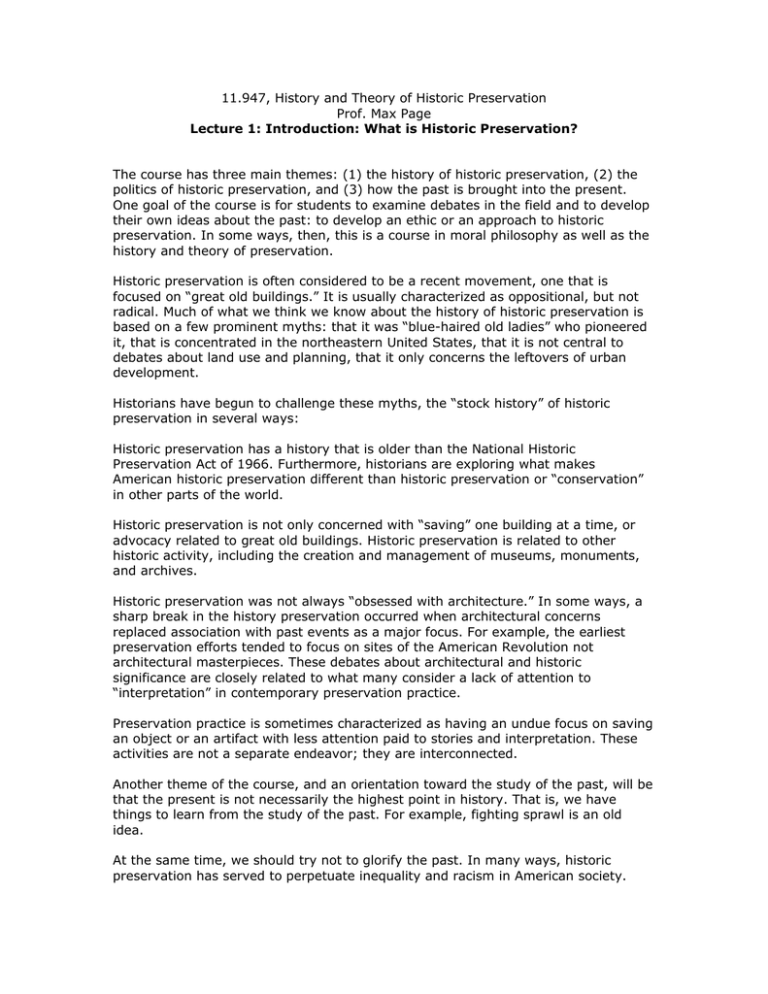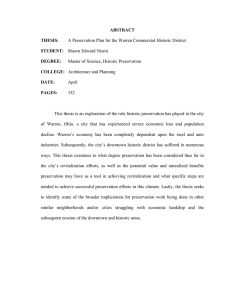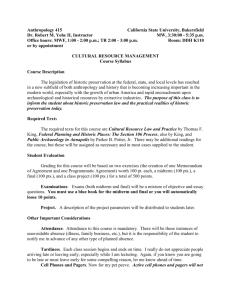11.947, History and Theory of Historic Preservation Prof. Max Page
advertisement

11.947, History and Theory of Historic Preservation Prof. Max Page Lecture 1: Introduction: What is Historic Preservation? The course has three main themes: (1) the history of historic preservation, (2) the politics of historic preservation, and (3) how the past is brought into the present. One goal of the course is for students to examine debates in the field and to develop their own ideas about the past: to develop an ethic or an approach to historic preservation. In some ways, then, this is a course in moral philosophy as well as the history and theory of preservation. Historic preservation is often considered to be a recent movement, one that is focused on “great old buildings.” It is usually characterized as oppositional, but not radical. Much of what we think we know about the history of historic preservation is based on a few prominent myths: that it was “blue-haired old ladies” who pioneered it, that is concentrated in the northeastern United States, that it is not central to debates about land use and planning, that it only concerns the leftovers of urban development. Historians have begun to challenge these myths, the “stock history” of historic preservation in several ways: Historic preservation has a history that is older than the National Historic Preservation Act of 1966. Furthermore, historians are exploring what makes American historic preservation different than historic preservation or “conservation” in other parts of the world. Historic preservation is not only concerned with “saving” one building at a time, or advocacy related to great old buildings. Historic preservation is related to other historic activity, including the creation and management of museums, monuments, and archives. Historic preservation was not always “obsessed with architecture.” In some ways, a sharp break in the history preservation occurred when architectural concerns replaced association with past events as a major focus. For example, the earliest preservation efforts tended to focus on sites of the American Revolution not architectural masterpieces. These debates about architectural and historic significance are closely related to what many consider a lack of attention to “interpretation” in contemporary preservation practice. Preservation practice is sometimes characterized as having an undue focus on saving an object or an artifact with less attention paid to stories and interpretation. These activities are not a separate endeavor; they are interconnected. Another theme of the course, and an orientation toward the study of the past, will be that the present is not necessarily the highest point in history. That is, we have things to learn from the study of the past. For example, fighting sprawl is an old idea. At the same time, we should try not to glorify the past. In many ways, historic preservation has served to perpetuate inequality and racism in American society. Certain stories were told, not others. Historic preservation is a powerful tool. It has the ability to add new stories, to challenge the stories already told. It is a myth that preservation activity began only in Massachusetts and Virginia. Scholars have recently described regional variations in the history of historic preservation. Economic development is another key theme in understanding historic preservation practice. It is one of the most powerful engines behind historic preservation today. Sometimes this tendency leads to results that are criticized as not merely a celebration of the old, but Disney-fication. Students should take the online survey about American attitudes about the past before the next class session. A short paper, described in the syllabus, is due at the beginning of the next class session. Slide Lecture The following four projects illustrate some of the key themes of the class. Two of these can be considered “cultural landscapes,” two as historic homes. Project #1: Maxwell Street, Chicago. Located on the near west side of Chicago, not far from the Hull House. The district was similar to the Lower East Side in New York, a bustling, crowded immigrant neighborhood centered around an outdoor market and shopping district. In the years of the Great Migration it became known as the birthplace of the urban blues. Performers often played outside of record shops on the sidewalk, with extension cords running inside to power electrical amplification. The area was the site of a recent preservation conflict related to expansion of the University of Illinois, Chicago. The definition of the term of “historic integrity” played a key part in this battle. In the end, the remaining historic structures were demolished, replaced by sports fields and surface parking. Project #2: Lower East Side, New York. The term “Lower East Side” has been used differently over the past two hundred years, referring to areas of different size and composition and with different boundaries in Lower Manhattan. The area was recently designated an historic district, but the boundaries of this district are peculiar. The way these boundaries were drawn reflects something worth noting about contemporary preservation practice. While the story of the Lower East Side involves a complex mixing of cultures, including free blacks, Irish, German, Jewish, Chinese, Polish, and many others, the district gives primary attention to Jewish history. A key term in this debate was “contributing buildings,” which again points to the centrality of “historic integrity” in contemporary practice. Project #3: Site of W.E.B. DuBois Home, Great Barrington, Mass. The home of DuBois, the eminent sociologist, critic, and founder of the NAACP, was demolished many years ago. All that remains is a ruin. Yet, the site has been designated a National Historic Landmark. Other sites which represent DuBois life in the town remain standing, but the home site remains undeveloped. What should be done here? Is reconstruction a good idea? How might DuBois be remembered at this site? Project #4: Emily Dickinson Museum, Amherst, Mass. The class will visit the homestead of the influential poet to reflect on and discuss the interpretation of the site. Of particular note is the use and interpretation of The Evergreens, one of two houses on the site. 11.947, Historic Preservation Prof. Max Page Lecture 1 Page 2 of 3 Finally, Another Place to Consider: Emmett Till Lynching, Money, Mississippi. The brutal murder of Till in 1955 was a major event in the Civil Rights Movement. The store where the Till allegedly whistled at a white woman, the afternoon before he was kidnapped and killed, still stands. What should happen at this site? What might future students, tourists, or activists encounter at this place? 11.947, Historic Preservation Prof. Max Page Lecture 1 Page 3 of 3





